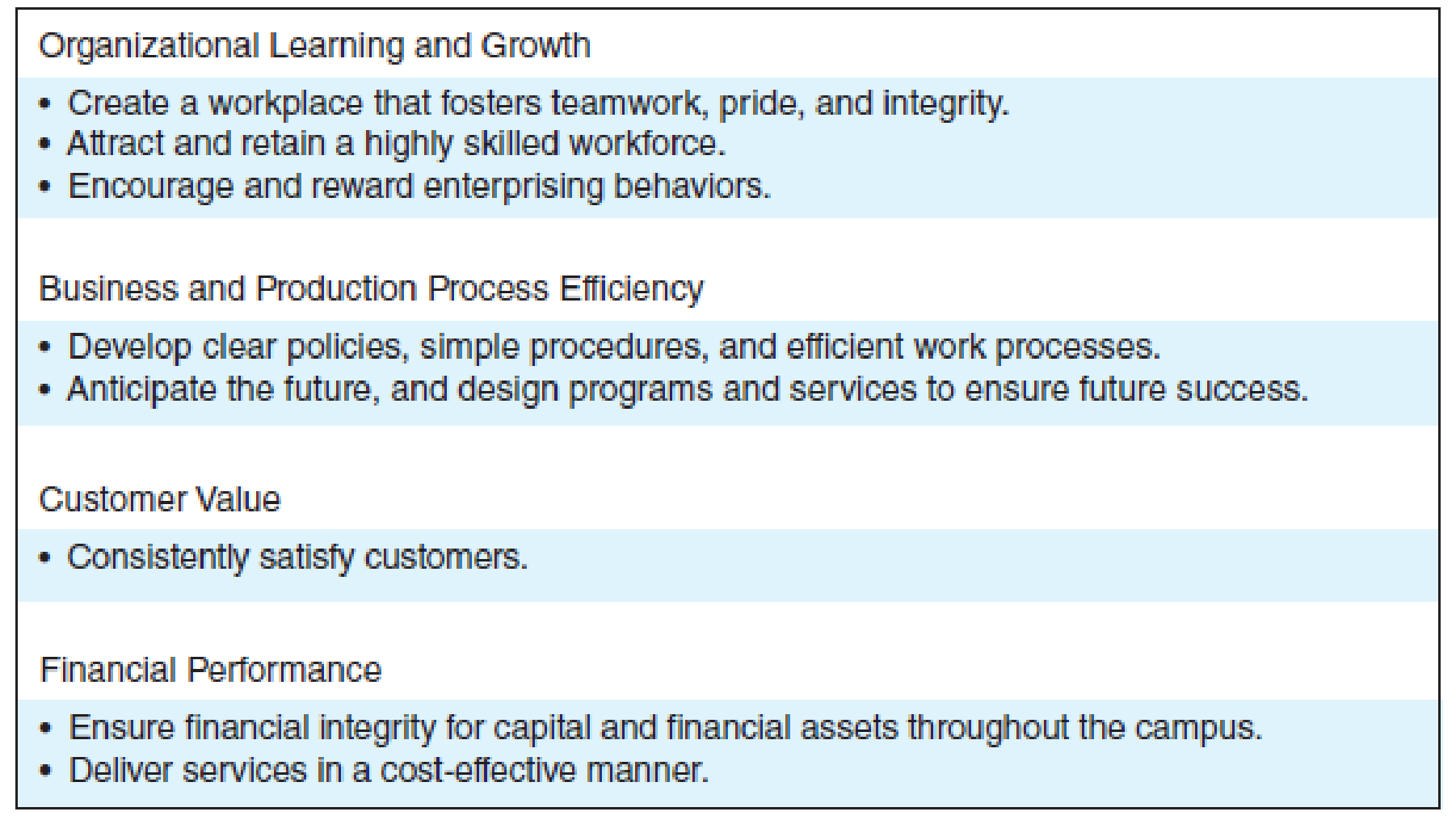
Concept explainers
Balanced Scorecards and Strategy Maps
Following several years of tight budgets, administrators at the University of California, Davis, looked for ways “to do more with less.” Janet Hamilton, vice chancellor of administration, researched books and articles, met with consultants, and talked to her counterparts at universities across the United States to find new management methods that could change the university from a bureaucratic organization to one that is customer-oriented. She learned about reengineering, total quality, and a variety of other management techniques. None of the management techniques appealed to her, until she came across articles about the balanced scorecard. She believed that the balanced scorecard was the right tool for the Davis campus, and she set about implementing it.
At first, Hamilton did not call her approach a “balanced scorecard,” because she feared that employees would think of this as just another management fad to endure until the administration went on to something new. Instead, she pilot-tested the balanced scorecard ideas in one service department, environmental health and safety (EHS), until it worked. With the success of EHS behind her, she moved to implement the balanced scorecard in other service departments, such as police, fire, and printing services.
Each department developed its own particular performance measures to achieve the following objectives (we have shortened the list to save space):

Required
- a. Was the vice chancellor overly cautious in not calling her approach a “balanced scorecard”?
- b. Comment on the wisdom of beginning a balanced scorecard with a pilot project. Would it be possible to extrapolate the experience of a service department, such as environmental health and safety, to an academic unit, such as a college of business?
- c. What opportunities and difficulties do you see in applying a balanced scorecard to a university setting?
Want to see the full answer?
Check out a sample textbook solution
Chapter 18 Solutions
FUNDAMENTALS OF COST ACCOUNTING
- Acorn Construction (calendar-year-end C corporation) has had rapid expansion during the last half of the current year due to the housing market's recovery. The company has record income and would like to maximize its cost recovery deduction for the current year. (Use MACRS Table 1, Table 2, Table 3, Table 4, and Table 5.) Note: Round your answer to the nearest whole dollar amount. Acorn provided you with the following information: Asset Placed in Service Basis New equipment and tools August 20 $ 3,800,000 Used light-duty trucks October 17 2,000,000 Used machinery November 6 1,525,000 Total $ 7,325,000 The used assets had been contributed to the business by its owner in a tax-deferred transaction two years ago. a. What is Acorn's maximum cost recovery deduction in the current year?arrow_forwardThe equivalent units of production are?arrow_forwardThe difference revenue of producing product B isarrow_forward
- What is the estimated ending inventory at June 30?arrow_forwardA manufacturing company allocates overhead at a fixed rate of $50 per hour based on direct labor hours. During the month, total overhead incurred was $375,000, and the total direct labor hours worked was 5,500. Job numbers 7-19 had 600 hours of direct labor. What is the amount of overhead allocated to job 7-19? a. $33,000 b. $28,500 c. $35,000 d. $30,000 helparrow_forwardSubject: financial accounting questionarrow_forward
 Cornerstones of Cost Management (Cornerstones Ser...AccountingISBN:9781305970663Author:Don R. Hansen, Maryanne M. MowenPublisher:Cengage LearningPrinciples of Accounting Volume 2AccountingISBN:9781947172609Author:OpenStaxPublisher:OpenStax College
Cornerstones of Cost Management (Cornerstones Ser...AccountingISBN:9781305970663Author:Don R. Hansen, Maryanne M. MowenPublisher:Cengage LearningPrinciples of Accounting Volume 2AccountingISBN:9781947172609Author:OpenStaxPublisher:OpenStax College Managerial AccountingAccountingISBN:9781337912020Author:Carl Warren, Ph.d. Cma William B. TaylerPublisher:South-Western College Pub
Managerial AccountingAccountingISBN:9781337912020Author:Carl Warren, Ph.d. Cma William B. TaylerPublisher:South-Western College Pub Financial And Managerial AccountingAccountingISBN:9781337902663Author:WARREN, Carl S.Publisher:Cengage Learning,
Financial And Managerial AccountingAccountingISBN:9781337902663Author:WARREN, Carl S.Publisher:Cengage Learning,



